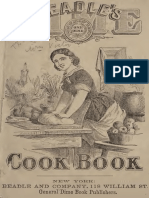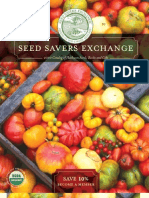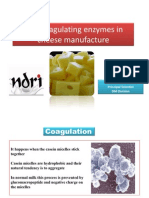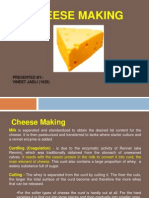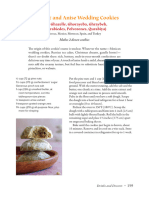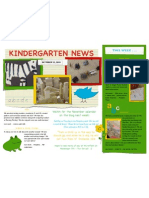The Art of Natural Cheesemaking - Foreword and Preface
The Art of Natural Cheesemaking - Foreword and Preface
Uploaded by
Chelsea Green PublishingCopyright:
Available Formats
The Art of Natural Cheesemaking - Foreword and Preface
The Art of Natural Cheesemaking - Foreword and Preface
Uploaded by
Chelsea Green PublishingCopyright
Available Formats
Share this document
Did you find this document useful?
Is this content inappropriate?
Copyright:
Available Formats
The Art of Natural Cheesemaking - Foreword and Preface
The Art of Natural Cheesemaking - Foreword and Preface
Uploaded by
Chelsea Green PublishingCopyright:
Available Formats
F ORE WO R D
Finally, the cheesemaking book Ive always wanted to read!
Cheese is such an important realm of fermentation and food preservation.
It transforms one of the most perishable of food products, milk, into a food
that can be stored and transported, even without refrigeration. And its brilliant diversity of flavors, smells, textures, and appearances exemplifies the
creativity and adaptability of human culture. One crucial factor in this diversity is microbial biodiversity, in that much of the variation in cheeses is due to
different types of organisms and microbial communities, as selected by aging
environment and surface treatment.
Most of the contemporary practice of cheesemaking, along with most of the
contemporary literature, relies on the use of laboratory-derived pure-strain
cultures, which are a relatively new phenomenon, possible for barely 150
years and widely used for a much shorter time. These pure-strain cultures
represent a radical departure from the entire earlier history of cheesemaking,
in which all cheeses relied upon the rich microbial communities indigenous to
milk, often accentuated by the practice of backslopping, which means incorporating a little of the previous batch into each subsequent one.
While cheese is such an extraordinary manifestation of biodiversity, the
logic behind most contemporary cheesemaking is that of monoculture, using
a single microbial strain (or possibly two or three) in lieu of the broader
microbial communities used traditionally. This is as true for most farmstead,
home, or hobby cheesemakers as it is for the mass producers.
The Art of Natural Cheesemaking reclaims this earlier cheesemaking legacy,
with great practical information on how to work with raw milk, along with
widely available kefir grains or yogurt, to encourage different types of microbial communities for different types of cheeses. David Asher poses a challenge
to conventional cheesemaking, as he puts it, and offers a bold vision of
cheesemaking as wild fermentation, by revisiting older methods that rely
upon the biodiversity of raw milk. We need to stop thinking of the cultural
regimes in cheese as individual strains of bacteria or fungi, he declares. It is
the reductionist industrial approach to cheesemaking that has singled out
what are believed to be the important players in an evolving cheese; the minor
players have been cast aside and forgotten. Yet its the combination of the
important players and their supporting microorganisms that make for a
healthy cheesemaking. For it is not an individual species that makes a cheese,
but a community of microorganisms . . .
The Art of Natural Cheesemaking starts with this impassioned and compelling manifesto; then the rest of the book is devoted to methods, in sufficient
detail to guide the reader through the process. I have spent time with David,
ix
The Art of Na t ur a l C h eesema k i ng
as both teacher and student. I have greatly enjoyed his delicious cheeses, and
Ive had success using those of his methods that I have tried. He provides clear
and methodical instructions, along with great illustrative photographs, to
guide you through making an incredible array of cheeses in your home
kitchen. And he does so relying entirely upon microbial communities indigenous to the milk, or those of yogurt or kefir. He offers simple techniques,
emphasizing improvisation with whats easily available rather than buying
specialized gadgetry.
This book appears in the context of a broader fermentation revival, in
which diverse ancient fermentation traditions are being reawakened and
explored anew after a period of eclipse by industrial production. Home practitioners and small local enterprises alike are experimenting with traditional
techniques. For anyone interested in traditional, low-tech cheesemaking, The
Art of Natural Cheesemaking will be an empowering tool. Welcome to the
fermentation revival!
Sandor Ellix Katz
March, 2015
P RE FACE
Im visiting this remote island off the west coast of British Columbia on a
writers retreat organized by a stranger. I received an e-mail from Jaylene out
of the blue, inviting me to come to Lasqueti to teach a cheesemaking class. She
asked me what she could offer to get me to come out and engage her community, far off the beaten track. I told Jaylene that I had wanted to visit her island
since Id first learned of it, and that I had been waiting for years for an invitation to come. All that Id ask, I added, would be for a quiet cabin to write in...
Lasqueti is different. It is a place where feral sheep have the run of the
island; where severe storms born of the Pacific crash ashore with ferocious
winds; and where Douglas firs, normally majestic broad-branched trees, cling
to the rocky soil and grow twisted and bonsai-like, prostrate against seaside
cliffs. It is a maverick island where the community does things their own way,
preferring to remain off-grid and off-ferry, preventing the development that
has scoured neighboring lands. And it is a place where residents grow gardens,
wildcraft, and seek out natural ways of living, and where DIY is a way of life.
It is places like these that truly appreciate my teachingsfor it is places like
these that have inspired my teachings. It is on the islands of the wild west
coast of Canada that I learned to farm. And it is on these islands that I taught
myself a new way to make cheese.
It is the land, it is the communities, and it is the people of the islands that
have inspired my ideals of a natural cheesemaking. Without the healthy
ecologies of the farm, the forest, and the sea; without the communities
self-sufficiencies; without the farmers spirit; and without the peoples rejection of the status quo, I would never have put together these thoughts.
The ecologies on these islands are vibrant and alive. You hear them first
thing in the morning with the dawn chorus of birds. You see them firsthand
walking through mature forest stands. And you taste them, toothe vitality of a healthy soil ecology coming through in the fine flavor of locally
grown produce.
These island communities are more introspective, observing the comings
and goings more acutely than mainland communities. It is clearer here how
tenuous our dependency on an overextended food system is, as nearly every
morsel of food in the grocery store arrives on a truck from off-island.
The island awareness encourages people to be more invested in what sustains them, and organic gardens are prevalent here as nowhere else in North
America. Farmers cultivate diverse farming operations, featuring livestock,
row crops, and orchards; compost-building plays a key role in the development of healthy soil; seed-saving practices adapt crops to the local growing
conditions; and permaculture systems ease the load on the land. Farmers here
xi
The Art of Na t ur a l C h eesema k i ng
also slaughter and butcher their own animals because, though local regulations restrict such activities, its the only way their isolated farms and
communities can remain viable.
The people of these islands support their farmers, who are considered
heroes and celebrities, sharing ranks with visiting health-care practitioners
and volunteer firefighters. Residents here question authority and the status
quo and strive to make the change they wish to see in the world.
It is thanks to the people here, like Jaylene, that I am encouraged to teach.
It is thanks to the many organizations here that are promoting food sovereignty and provide venues for my classes that Im able to teach; and now, it is
thanks to Chelsea Green that my words will teach a far greater audience than
I could possibly reach.
Lasqueti Island, British Columbia, Canada
April, 2014
The healthy ecologies of the West Coast are the inspiration for my cheesemaking.
xii
You might also like
- Art Natural Cheesemaking Traditional Non Industrial PDF 352c963d1Document2 pagesArt Natural Cheesemaking Traditional Non Industrial PDF 352c963d1Alejandro LozanoNo ratings yet
- NOMA 2.0 - BIG - ArchDailyDocument10 pagesNOMA 2.0 - BIG - ArchDailyDaiana Maciulschi0% (1)
- Avionic Emb 145-3Document130 pagesAvionic Emb 145-3Henry Blandon100% (4)
- The New Bread Basket - Chapter One: The Farmer, The Miller, and The BakerDocument18 pagesThe New Bread Basket - Chapter One: The Farmer, The Miller, and The BakerChelsea Green PublishingNo ratings yet
- Bread Baking at Home HandoutDocument6 pagesBread Baking at Home HandoutjcarzolaNo ratings yet
- Raw Milk Recipe Book by Organic Pastures Dairy CompanyDocument15 pagesRaw Milk Recipe Book by Organic Pastures Dairy CompanyBryan Castañeda100% (1)
- Butter and CheeseDocument178 pagesButter and CheeseDedelun Azul100% (2)
- On-Farm Small Scale Cheesemaking - A Beginner's Guide: Published in Association With The Society of Dairy TechnologyDocument24 pagesOn-Farm Small Scale Cheesemaking - A Beginner's Guide: Published in Association With The Society of Dairy TechnologyAdnanwNo ratings yet
- Farmhouse Cheesemakers Workbook FINALDocument67 pagesFarmhouse Cheesemakers Workbook FINALIshan PoudelNo ratings yet
- Artisan Goat Cheese PDFDocument42 pagesArtisan Goat Cheese PDFAlejandro José Linares Díaz100% (2)
- FLNG Market Update Stephen Gordon ClarksonsDocument38 pagesFLNG Market Update Stephen Gordon ClarksonsrajasekharboNo ratings yet
- The Art of Natural Cheesemaking - Chapter One: A Natural Cheesemaking ManifestoDocument8 pagesThe Art of Natural Cheesemaking - Chapter One: A Natural Cheesemaking ManifestoChelsea Green PublishingNo ratings yet
- Heirloom Recipe Book - e PDFDocument174 pagesHeirloom Recipe Book - e PDFLizeth Bañez DalupangNo ratings yet
- The Cheesemonger's Seasons: Recipes for Enjoying Cheese with Ripe Fruits and VegetablesFrom EverandThe Cheesemonger's Seasons: Recipes for Enjoying Cheese with Ripe Fruits and VegetablesNo ratings yet
- Milk Into Cheese: The Foundations of Natural Cheesemaking Using Traditional Concepts, Tools, and TechniquesFrom EverandMilk Into Cheese: The Foundations of Natural Cheesemaking Using Traditional Concepts, Tools, and TechniquesNo ratings yet
- The Joy of Keeping a Root Cellar: Canning, Freezing, Drying, Smoking, and Preserving the HarvestFrom EverandThe Joy of Keeping a Root Cellar: Canning, Freezing, Drying, Smoking, and Preserving the HarvestNo ratings yet
- Sample Recipes From The Occidental Arts and Ecology Center CookbookDocument6 pagesSample Recipes From The Occidental Arts and Ecology Center CookbookChelsea Green PublishingNo ratings yet
- Making Chevre PDFDocument3 pagesMaking Chevre PDFAndreas MeyerNo ratings yet
- Sourdough Mastery: A Comprehensive Guide to Perfecting the Art of Bread MakingFrom EverandSourdough Mastery: A Comprehensive Guide to Perfecting the Art of Bread MakingNo ratings yet
- Introduction To Cheesemaking The Artisan CheesemakerDocument43 pagesIntroduction To Cheesemaking The Artisan CheesemakerChrissy DeSimoneNo ratings yet
- Norwich Sourdough Bread Recipe - Wild YeastDocument2 pagesNorwich Sourdough Bread Recipe - Wild YeastkikicreNo ratings yet
- Canning Meat Poultry and GameDocument16 pagesCanning Meat Poultry and GameAnnette PhilpotNo ratings yet
- Cheese GoudaDocument24 pagesCheese GoudaJhon Jairo ZambranoNo ratings yet
- Milk Kefir GuideDocument14 pagesMilk Kefir Guidehallowed.ivanovich333No ratings yet
- Tartine Bread Bakery Reveals Its SecretsDocument3 pagesTartine Bread Bakery Reveals Its SecretsEmilie ChateletNo ratings yet
- Carol's Universal Skillet Bread - A Recipe From The Resilient GardenerDocument4 pagesCarol's Universal Skillet Bread - A Recipe From The Resilient GardenerChelsea Green PublishingNo ratings yet
- Food PreservingDocument13 pagesFood Preservingflame crystalNo ratings yet
- French Food GlossaryDocument6 pagesFrench Food GlossarymarkakidNo ratings yet
- Ryzon Baking BookDocument88 pagesRyzon Baking Bookbsaracco1100% (4)
- Hispanic Cheese GuideDocument49 pagesHispanic Cheese Guide1roland100% (1)
- Humble Book Bundle - Essential Cookbooks by Williams Sonoma (Pay What You Want and Help Charity)Document1 pageHumble Book Bundle - Essential Cookbooks by Williams Sonoma (Pay What You Want and Help Charity)1tmac3No ratings yet
- Options For Storing Potatoes at HomeDocument4 pagesOptions For Storing Potatoes at HomeElviraSyamsir-Siswanto100% (1)
- The Resilient Farm and Homestead Table of ContentsDocument2 pagesThe Resilient Farm and Homestead Table of ContentsChelsea Green PublishingNo ratings yet
- 2011 Mechanisms of Coagulation Kindstedt PDFDocument52 pages2011 Mechanisms of Coagulation Kindstedt PDFAndjela MartinovićNo ratings yet
- Win The War Cook BookDocument172 pagesWin The War Cook BookSandra MianNo ratings yet
- Food Forest WorksheetDocument7 pagesFood Forest Worksheetapi-258182324No ratings yet
- The Animal Farm Buttermilk Cookbook: Recipes and Reflections from a Small Vermont DairyFrom EverandThe Animal Farm Buttermilk Cookbook: Recipes and Reflections from a Small Vermont DairyRating: 3.5 out of 5 stars3.5/5 (4)
- CLComp 1601-2000Document404 pagesCLComp 1601-2000api-3832053No ratings yet
- Canning For The Revolution!: A PrimerDocument16 pagesCanning For The Revolution!: A PrimerLeif BreckeNo ratings yet
- Beadle's Dime Cook BookDocument100 pagesBeadle's Dime Cook BookBianca PradoNo ratings yet
- FermentationDocument38 pagesFermentationpost harvest technology70% (10)
- Step-by-step Guide To Preserving Vegetables Fermenting, Pickling, Canning, Dehydrating And Freezing Your Favorite ProductsFrom EverandStep-by-step Guide To Preserving Vegetables Fermenting, Pickling, Canning, Dehydrating And Freezing Your Favorite ProductsNo ratings yet
- Spirulina Improves Growth - Egg Production and Meat Quality - 2012Document15 pagesSpirulina Improves Growth - Egg Production and Meat Quality - 2012julesverneNo ratings yet
- Seed Savers Exchange 2010 CatalogDocument101 pagesSeed Savers Exchange 2010 Catalogsprig_jack3706100% (1)
- Cheese Making 101Document11 pagesCheese Making 101TegNo ratings yet
- The Cheesemakers AppretinceDocument177 pagesThe Cheesemakers Appretincedescarao100% (9)
- Pressure Canning 2 Books in 1 - Pressure Canning For Beginners + Preserving Bible.Document244 pagesPressure Canning 2 Books in 1 - Pressure Canning For Beginners + Preserving Bible.Audio CanvasNo ratings yet
- Soy FlourDocument71 pagesSoy FlourMichal Slavíček100% (1)
- Caramel Apple Recipe: Special Equipment: Candy Thermometer, and Lollipop SticksDocument10 pagesCaramel Apple Recipe: Special Equipment: Candy Thermometer, and Lollipop SticksAnj Serdenia100% (1)
- Mastering Artisan Cheesemaking: IntroductionDocument4 pagesMastering Artisan Cheesemaking: IntroductionChelsea Green Publishing100% (1)
- Growing The Potato Crop (PDFDrive)Document394 pagesGrowing The Potato Crop (PDFDrive)macaco logoNo ratings yet
- Milk Coagulating Enzymes in Cheese ManufactureDocument27 pagesMilk Coagulating Enzymes in Cheese Manufactureskmishra84100% (1)
- The Art of Preserving Goat: A Little Book Full of All the Information You NeedFrom EverandThe Art of Preserving Goat: A Little Book Full of All the Information You NeedNo ratings yet
- Baking Update - Bun and Roll ProductionsDocument2 pagesBaking Update - Bun and Roll ProductionsAgnesya AdifiliaNo ratings yet
- Ecology of Fermented Foods PDFDocument7 pagesEcology of Fermented Foods PDFfabriziozara100% (1)
- Wheat To FlourDocument6 pagesWheat To Flourkumari shaliniNo ratings yet
- Rooftop Organic Vegetable Garden, Four Year Crop RotationDocument22 pagesRooftop Organic Vegetable Garden, Four Year Crop RotationDan HarveyyNo ratings yet
- Cheese MakingDocument6 pagesCheese MakingVineetNo ratings yet
- How To Eat WellDocument68 pagesHow To Eat Welleledidi100% (1)
- Fermented Hot Sauce - Simple and Delicious!: Home Energizing Recipes 251 CommentsDocument32 pagesFermented Hot Sauce - Simple and Delicious!: Home Energizing Recipes 251 CommentsAna VillanuevaNo ratings yet
- The Courage of Birds: Preface and IntroductionDocument4 pagesThe Courage of Birds: Preface and IntroductionChelsea Green PublishingNo ratings yet
- Chile, Clove, and Cardamom: Cucumber, Fennel, and Garlic DipDocument2 pagesChile, Clove, and Cardamom: Cucumber, Fennel, and Garlic DipChelsea Green PublishingNo ratings yet
- Chile, Clove, and Cardamom: Pine Nut and Anise Wedding CookiesDocument1 pageChile, Clove, and Cardamom: Pine Nut and Anise Wedding CookiesChelsea Green PublishingNo ratings yet
- Chile, Clove, and Cardamom: Sweet Potato FriesDocument2 pagesChile, Clove, and Cardamom: Sweet Potato FriesChelsea Green PublishingNo ratings yet
- Chile, Clove, and Cardamom: Building Your Own Desert PantryDocument3 pagesChile, Clove, and Cardamom: Building Your Own Desert PantryChelsea Green PublishingNo ratings yet
- The Courage of Birds: Table of ContentsDocument2 pagesThe Courage of Birds: Table of ContentsChelsea Green PublishingNo ratings yet
- Chile, Clove, and Cardamom: Roast Chicken With Tarragon and CapersDocument2 pagesChile, Clove, and Cardamom: Roast Chicken With Tarragon and CapersChelsea Green PublishingNo ratings yet
- Chile, Clove, and Cardamom: Introduction Opening Up To The Fragrances and Flavors of Desert CuisinesDocument3 pagesChile, Clove, and Cardamom: Introduction Opening Up To The Fragrances and Flavors of Desert CuisinesChelsea Green PublishingNo ratings yet
- Chile, Clove, and Cardamom: Table of ContentsDocument1 pageChile, Clove, and Cardamom: Table of ContentsChelsea Green PublishingNo ratings yet
- My Regenerative Kitchen: Mushroom Larb Lettuce CupsDocument1 pageMy Regenerative Kitchen: Mushroom Larb Lettuce CupsChelsea Green PublishingNo ratings yet
- My Regenerative Kitchen: Foreword by Alice WatersDocument2 pagesMy Regenerative Kitchen: Foreword by Alice WatersChelsea Green PublishingNo ratings yet
- My Regenerative Kitchen: Vibrational Crispy ChickpeasDocument1 pageMy Regenerative Kitchen: Vibrational Crispy ChickpeasChelsea Green PublishingNo ratings yet
- My Regenerative Kitchen: Shaved Carrot Salad With Mirin VinaigretteDocument1 pageMy Regenerative Kitchen: Shaved Carrot Salad With Mirin VinaigretteChelsea Green PublishingNo ratings yet
- My Regenerative Kitchen: Macerated Cherries, Fresh Cream, and Coconut CrumbleDocument1 pageMy Regenerative Kitchen: Macerated Cherries, Fresh Cream, and Coconut CrumbleChelsea Green PublishingNo ratings yet
- My Regenerative Kitchen: Sherry Agrodolce Honeynut Squash With Fried Squash SeedsDocument1 pageMy Regenerative Kitchen: Sherry Agrodolce Honeynut Squash With Fried Squash SeedsChelsea Green PublishingNo ratings yet
- My Regenerative Kitchen: Table of ContentsDocument1 pageMy Regenerative Kitchen: Table of ContentsChelsea Green PublishingNo ratings yet
- The Healthy Bones Plant-Based Nutrition Plan and Cookbook: California Rainbow Spring RollsDocument1 pageThe Healthy Bones Plant-Based Nutrition Plan and Cookbook: California Rainbow Spring RollsChelsea Green Publishing100% (1)
- The Healthy Bones Plant-Based Nutrition Plan and Cookbook: IntroductionDocument8 pagesThe Healthy Bones Plant-Based Nutrition Plan and Cookbook: IntroductionChelsea Green PublishingNo ratings yet
- The Hungry Ghost Bread Book: Table of ContentsDocument2 pagesThe Hungry Ghost Bread Book: Table of ContentsChelsea Green PublishingNo ratings yet
- In Search of The Perfect Peach: ForewordDocument5 pagesIn Search of The Perfect Peach: ForewordChelsea Green PublishingNo ratings yet
- Getting Healthy in Toxic Times: Table of ContentsDocument1 pageGetting Healthy in Toxic Times: Table of ContentsChelsea Green PublishingNo ratings yet
- Getting Healthy in Toxic Times: IntroductionDocument10 pagesGetting Healthy in Toxic Times: IntroductionChelsea Green PublishingNo ratings yet
- Milk Into Cheese: Table of ContentsDocument2 pagesMilk Into Cheese: Table of ContentsChelsea Green Publishing100% (1)
- The Healthy Bones Plant-Based Nutrition Plan and Cookbook: Table of ContentsDocument2 pagesThe Healthy Bones Plant-Based Nutrition Plan and Cookbook: Table of ContentsChelsea Green PublishingNo ratings yet
- Milk Into Cheese: IntroductionDocument12 pagesMilk Into Cheese: IntroductionChelsea Green PublishingNo ratings yet
- The Biochar Handbook: Building SoilDocument20 pagesThe Biochar Handbook: Building SoilChelsea Green Publishing100% (3)
- The Hungry Ghost Bread Book: Tools of The TradeDocument7 pagesThe Hungry Ghost Bread Book: Tools of The TradeChelsea Green PublishingNo ratings yet
- A Parent's Guide To Childhood Cancer Chapter 2: Build Out The TeamDocument14 pagesA Parent's Guide To Childhood Cancer Chapter 2: Build Out The TeamChelsea Green PublishingNo ratings yet
- Feather Trails Table of ContentsDocument2 pagesFeather Trails Table of ContentsChelsea Green PublishingNo ratings yet
- Feather Trails, Chapter 10: Night WhispersDocument9 pagesFeather Trails, Chapter 10: Night WhispersChelsea Green PublishingNo ratings yet
- Counted With The StarsDocument35 pagesCounted With The StarsBethany House PublishersNo ratings yet
- Differences Between Grammatical and Ungrammatical Structure in English LanguageDocument3 pagesDifferences Between Grammatical and Ungrammatical Structure in English LanguageEyna Azlina Alias100% (2)
- Lewis Carrol: Birth: DeathDocument21 pagesLewis Carrol: Birth: DeathmarialuvsjeffNo ratings yet
- WR&M Hacked To 2D6Document9 pagesWR&M Hacked To 2D6Paulo FrotaNo ratings yet
- Ruston v. Church of Jesus Christ of Latter Day Saints Et Al - Document No. 34Document2 pagesRuston v. Church of Jesus Christ of Latter Day Saints Et Al - Document No. 34Justia.comNo ratings yet
- Lecture 13: Delta Function Potential, Node Theorem, and Simple Harmonic OscillatorDocument13 pagesLecture 13: Delta Function Potential, Node Theorem, and Simple Harmonic OscillatorBeenishMuazzamNo ratings yet
- 6.b. RGP Toric Lens DesignDocument4 pages6.b. RGP Toric Lens Designblack00swanNo ratings yet
- A. Duties and Responsibilities To The Society PDFDocument14 pagesA. Duties and Responsibilities To The Society PDFMai Lin Granados100% (1)
- Kami Export - 1.2.6 Practice - Comparing Governments (Practice)Document8 pagesKami Export - 1.2.6 Practice - Comparing Governments (Practice)shindelmangordonNo ratings yet
- Osteoarthritis: Degenerative Joint Disease - Prevalensi Meningkat Seiring DG Usia, Meningkat 2-10x DR Usia 30-65 THDocument58 pagesOsteoarthritis: Degenerative Joint Disease - Prevalensi Meningkat Seiring DG Usia, Meningkat 2-10x DR Usia 30-65 THFishIngNo ratings yet
- HHS Public Access: Raising Bilingual Children: A Qualitative Study of Parental Attitudes, Beliefs, and Intended BehaviorsDocument16 pagesHHS Public Access: Raising Bilingual Children: A Qualitative Study of Parental Attitudes, Beliefs, and Intended BehaviorsARFA MUNAWELLANo ratings yet
- Proposal Sponsorship Spora EnglishDocument29 pagesProposal Sponsorship Spora EnglishVindy Cesariana0% (1)
- ArchitecturaldigestDocument2 pagesArchitecturaldigestSimone NeivaNo ratings yet
- Yulistia Rahmi Putri 19040001 - Reading Report Assessment For Young LearnersDocument5 pagesYulistia Rahmi Putri 19040001 - Reading Report Assessment For Young LearnersYulistia Rahmi PutriNo ratings yet
- Trick To Remember Salt Water Lakes of Rajasthan - GK TricksDocument3 pagesTrick To Remember Salt Water Lakes of Rajasthan - GK TricksJAMESJANUSGENIUS5678100% (1)
- Bscmathsv&ViDocument11 pagesBscmathsv&ViDhiraj RajputNo ratings yet
- Wilbur Smith Is A Misogynist ShitbagDocument125 pagesWilbur Smith Is A Misogynist ShitbagvzllhfjiNo ratings yet
- Connective WordsDocument1 pageConnective Wordsapi-262266786No ratings yet
- Roth - From Free WombDocument19 pagesRoth - From Free WombNubss SSNo ratings yet
- Unit 4: MarketingDocument33 pagesUnit 4: Marketingkhushboo_gupta1326No ratings yet
- U4.4.1 - Grammar - Presentation and ExercisesDocument32 pagesU4.4.1 - Grammar - Presentation and ExercisesASTRID NAOMI MALDONADO HUERTANo ratings yet
- FTPDocument3 pagesFTPDani SupriyadiNo ratings yet
- Kindergarten News: This Week - .Document1 pageKindergarten News: This Week - .farmgirl7182No ratings yet
- Abdul Monem Group.Document17 pagesAbdul Monem Group.Rasibul Islam RafiNo ratings yet
- SM 1cultureDocument128 pagesSM 1cultureshivam mishraNo ratings yet
- History Coursework SampleDocument5 pagesHistory Coursework Samplef5de9mre100% (2)
- RISA Seismic Moment ConnectionsDocument11 pagesRISA Seismic Moment ConnectionsJackNo ratings yet
- Forecast Quý 1 Năm 2024Document78 pagesForecast Quý 1 Năm 2024diemngocxuanhoa2006No ratings yet








































